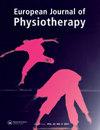Hand function 6 weeks following non-surgically treated proximal phalangeal fractures and factors associated to upper extremity disability
IF 1.1
Q3 REHABILITATION
引用次数: 1
Abstract
Abstract Purpose To describe hand function, and investigate adherence to a rehabilitation protocol and factors associated with upper extremity disability in non-surgically treated proximal phalangeal fractures. Material and methods In a prospective cohort study, 86 patients (58 women, mean age of 49 years) were assessed at cast removal and 6 weeks follow-up. Adherence was registered in a diary. Factors potentially associated with disability were assessed in a logistic regression model. Results At 6 weeks, the mean total active range of motion in the injured finger was 84% of the uninjured finger and median pain intensity levels were low (VAS <20). Mean grip strength was 66% of the uninjured hand and 28% perceived high upper extremity disability (QuickDASH score ≥30). Most patients adhered to exercise and night splint regime. The strongest associated factors with high upper extremity disability were more days in cast (Odds ratio 1.429, 95% CI 1.110–1.840) and fear of movement (Odds ratio 1.119, 95% CI 0.990–1.256) in the final regression model (Nagelkerke R Square 0.46). Conclusion Most patients regain early satisfactory hand function, but a quarter still perceives high upper extremity disability. Longer immobilisation time in particular and fear of movement are important factors that may negatively affect the early outcome.非手术治疗近节指骨骨折后6周的手功能及与上肢残疾相关的因素
摘要目的描述非手术治疗近节指骨骨折的手功能,并研究康复方案的依从性以及与上肢残疾相关的因素。材料和方法在一项前瞻性队列研究中,86名患者(58名女性,平均年龄49岁) 年)进行了评估 周随访。坚持记录在日记中。在逻辑回归模型中评估了可能与残疾相关的因素。6时的结果 周,受伤手指的平均总活动范围为未受伤手指的84%,中位疼痛强度水平较低(VAS<20)。平均握力为66%的未受伤手和28%的高上肢残疾(QuickDASH评分≥30)。大多数患者坚持运动和夜间夹板方案。在最终回归模型(Nagelkerke R Square 0.46)中,与高上肢功能障碍最相关的因素是铸造天数(比值比1.429,95%CI 1.110-1.840)和对运动的恐惧(比值比1.119,95%CI 0.990-1.256)。尤其是更长的固定时间和对运动的恐惧是可能对早期结果产生负面影响的重要因素。
本文章由计算机程序翻译,如有差异,请以英文原文为准。
求助全文
约1分钟内获得全文
求助全文

 求助内容:
求助内容: 应助结果提醒方式:
应助结果提醒方式:


